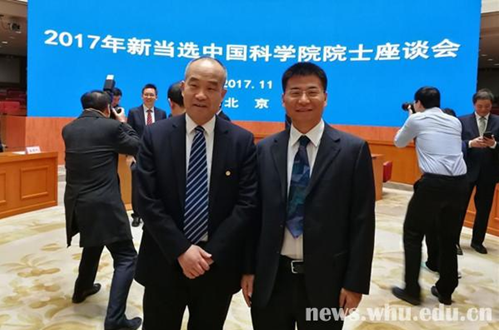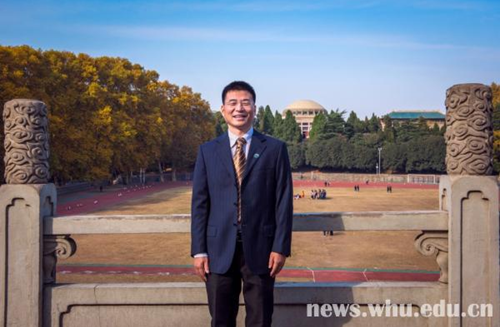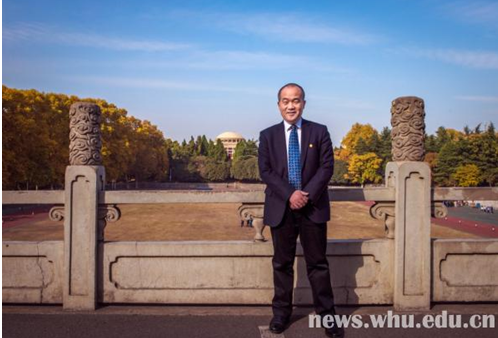On November 28th, the Chinese Academy of Sciences announced its 2017 list of 61 newly elected academicians, which includes two WHU professors and one WHU alumni. Xu Hongxing, Dean of School of Physics and Technology, was elected the academician of Division of Mathematics and Physics; President Dou Xiankang was elected the academician of Division of Earth Science. Alumni Wang Xiaofan was also elected, who graduated from School of Chemistry and Molecular Sciences in WHU in 1978. In addition, the Chinese Academy of Sciences has 16 new foreign academicians this year.

President Dou Xiankang ang Professor Xu Hongxing at the meeting for newly selected CAS members
Xu Hongxing, born in 1969, serves as Dean of School of Physics and Technology in WHU. He has long been engaged in the research of frontier fields such as plasmonics, nanophotonics, single molecule spectroscopy and nano optics chip, and has made groundbreaking and systematic achievements. He discovered in his experiment that pairs of metal nanoparticles can exert huge electromagnetic field enhancement effect in their nanogaps under the action of light field, which is the reason of single-molecule surface-enhanced Raman spectroscopy and also the physical basis of some other researches based on nanogaps effect. He systematically studied the produce conditions of single-molecule surface-enhanced Raman spectroscopy and analyzed its main mechanisms. He also made contributions to the research in several important field by proposing plasmoinic dynamics and single-molecule capture, surface-enhanced Raman and surface-enhanced fluorescence unified theory, discovering nantenna effect of surface-enhanced spectroscopy and developing a high-vacuum tip enhanced Raman spectroscopy system to achieve the plasmon catalytic reaction. He systematically studied the propagation of plasmon in the nano-waveguide. He discovered that the plasmon under the light drive presents a propagation mode that overcomes the diffraction limit of light, and that different modes of interference form a tunable optical beat on the nanowire. This discovery lays the physical basis for the light propagation and the regulation at the nanoscale. Other discoveries included the physical mechanism and regulation mechanism of the excitation, propagation, emission and exciton interaction of the nano-waveguide plasmon. Cascade of network router, complete optical logic, half-adder and optical logic has been realized in the nano-waveguide. These efforts made possible the miniaturization and high-density integration of optics, which is an important basis for the study of plasmonic nanochip.

Professor Xu Hongxing
Xu’s achievements have been recorded in his over 180 papers in internationally renowned scientific journals, which have been quoted by SCI Magazine for more than 12,000 times. There are 33 papers with 100 times’ single quotation at the h-factors of 54. Among them, there are two articles cited about 1660 times (Physical Review Letters 1999, 83, 4357) and 1190 times (Physical Review E 2000, 62, 4318) Milestone paper since the journal’s initial publication). He has been invited to give more than 60 reports on international conferences. He has host more than ten renown international academic conferences as the chairman. He is Associate Editor of Nanoscale and was Associate Editor of Optics Express. From 2014 to 2016, he has been consecutively selected by Elsevier as one of the Most Cited Chinese Researchers. In addition, he was invited to take part in the publication of the monograph Nanophotonics: Manipulating Light with Plasmons.
Dou Xiankang, born in 1966, started his career in space physics in July 1987 and was appointed as the president of Wuhan University in December 2016. He has been devoted to the theoretical observational and experimental research on the middle and upper atmospheres. He sticks to the disciplinary frontier and has created a series of self-developed lidar observation system, among which, the car wind-detecting lidar system has filled the domestic blank in this field and its techniques have reached the world’s leading level. He has also presented the successful debut of the quantum lidar based on the conversion technology, creating a new system of lidar detection. On the basis of the pioneering work on the observation equipment, a great number of systematic and innovative achievements have been made in such fields of the mid-top area of the atmospheric dynamics and photochemistry. Moreover, he is the owner of 27 national invention patents and the author of more than 110 international papers.

President Dou Xiankang
His main academic achievements and contributions are as follows. Firstly, his work promoted the development of lidar detection technology, and succeeded to create the first quantum lidar based on the conversion technology, laying a a solid foundation for the observation in the middle and upper atmosphere. Secondly, the self-designed equipment and observation experiments are utilized to reveal the mechanism of interaction between neutral atmosphere and ionization components. Thirdly,in the research of lower atmospheric’ response to the middle and upper atmosphere, several new mechanisms of atmospheric fluctuation affecting the mid-upper atmosphere, variability have been proposed to the application of the modeling and accurate prediction.
Additionally, Dou Xiankang and his team have had 48 papers published in Journal of Geography Research (the top journal of its field) from 2012-2017, second only to the National Center for Atmospheric Science (NCAR) and ranking second among the international congenners of research institutions and universities. Moreover, his students, research groups and laboratories have achieved great success under his leadership.
By now, there have been 18 CAS and CAE academicians, ranking among the front row of domestic colleges and universities. Among them, there are 11 members of the Chinese Academy of Sciences, including: Zhan Quan, Zhuo Renxi, Li Deren, Deng Zixin, Zhang Lina, Gong Jianya, Shu Hongbing, Zhu Yuxian, Xia Jun, Xu Hongxing and Dou Xiankang, and 7 academician of Chinese Academy of Engineering : Li Deren, Ning Jinsheng, Liu Jingnan, Zhang Zuxun, Ji Zhi, Li Xiaohong, Li Jiancheng.
Photo by Peng Min
Rewritten by Shen Yuxi, edited by Hu Sijia